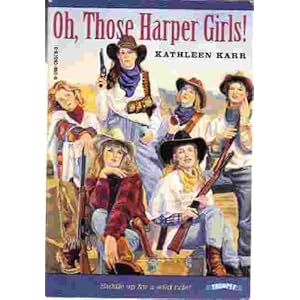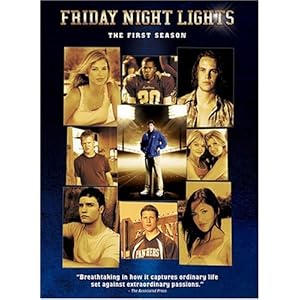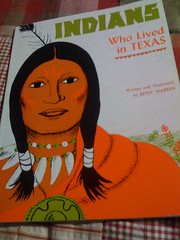What is it about boys and Indians? Three brothers from a family I grew up with—Tommy, Barry, and Eddie—were fascinated with all things Native American. Tommy, who was my age, brought his authentic Indian headdress to school for show and tell. The boys were in Boy Scouts, and it was the Native American aspects of the scouting mythology that caught and held their attention. They took care of our school mascot, a bobcat, in their backyard, and I think it was some kind of symbol for them not only of the school but also of their Native American heritage or aspirations or something.
Fast forward to 2009, and many boys are still interested in Native American history and rituals and culture. We’re studying Texas history this year, and you can’t study Texas heritage and traditions without serving up a good dollop of Native American history, particularly the history of the Plains Indians and that of the tribes of Indians who lived along the Gulf Coast and in the Piney Woods of East Texas. And it’s necessary to discuss all sorts of sticky subjects: cultural genocide, assimilation, adaptation, revenge, war, racist attitudes and all of the baggage that goes with the complicated history of the Europeans meeting, and clashing with, the Native Americans.
Sometimes all of that is much easier to discuss in the context of fiction. Here are a few books that might be both fascinating to the boys (or even girls) in your classroom or homeschool and useful in discussing the history of AngloEuropean and Native American relations. They’re all set in or near Texas.
Comanche Song by Janice Shefelman. Set in 1840. Tsena, the sixteen year old son of a Comanche chief, longs to prove himself as a warrior, but he also supports his father’s efforts to keep peace with the Texans who are crowding into the Comanches’ hunting territories. When Tsena accompanies his father and the other chiefs to San Antonio, he survives the Council House Massacre (a real historical event) only because the white men consider him still a boy. And when Tsena escapes and rejoins his tribe, he is faced with the decision of whether to take revenge on those who have hurt him or to help those who have helped him. How can Tsena become a man and listen to the voice of his Spirit Wolf in a world that is becoming less and less hospitable to him and his tribe’s way of life? The story is informative and interesting without being culturally condescending and without changing history to make either side in this clash seem to be without fault.
Spirit of Iron by Janice Shefelman. Set in 1850. Here’s the token girl book in which fifteen year old Mina Jordan dresses up like a boy aand runs away to Comancheria (Comanche Territory) to help the Texas Rangers find her kidnapped Lipan Apache best friend, Amaya. I still say it’s a boy thing, even though I enjoyed this book and the others. I never actually wanted to BE an Indian or adopt Native American customs or anything.
The Wolf’s Tooth by G. Clifton Wisler. Set in 1858-1859. Elias Walsh isn’t excited about leaving his friends and his home in Waco to move to an isolated Indian reservation just so that his schoolteacher father can “seek out those who want to learn, help them along the path to knowledge.” As far as Elias can see, the few Indians who live on the reservation aren’t too interested in learning or knowledge, just survival. And Thomas Three Feathers, the family’s Tonkawa interpreter and boarder, is strange and stand-offish. Then, the boys go out together to hunt the wolf that has been menacing the community, and Elias is forced to grow up fast.
Buffalo Moon by G. Clifton Wisler. Set in 1859-1860. Fourteen year old Willie Delamer doesn’t want to leave his ranch home in Texas to go to school in New Orleans. He’s sure that he knows all he needs to know, or if he doesn’t, the learning he needs isn’t to be found in a city school. So Willie runs away with his pony across the Brazos River into Indian country. As he lives with the Indians that his father has worked hard to respect and gain respect from, Willie becomes a man while learning to hunt buffalo, wrestle, race horses and make peace with his enemies. The sequel to this book is Thunder on the Tennessee, about Willie Delamer’s adventures during the Civil War as the now fifteen year old fights for Texas and the Confederacy.
Winter of the Wolf by G. Clifton Wisler. Set during the Civil War in 1864. The summer of T.J.’s fifteenth year, his father and his two older brothers ride off to fight the Yankees with Texas General John Bell Hood. T.J. must become the man of the family, and when a huge and seemingly invincible wolf threatens the livestock and the livelihood of the family, T.J. enlists the help of his Comanche friend, Yellow Feather, and the two of them set out to kill the Demon Wolf. The is one is so similar to The Wolf’s Tooth that it makes me think that Mr. Wisler is not above recycling plots. However, if you like one, you’ll probably like it recycled, too, with names changed to protect.
 The Harper girls live in Texas, in 1869, just after the Civil War, with their refined mother and their ne’er-do-well daddy on the Double H Ranch. Unfortunately, the bank is going to foreclose on the Double H if the Harpers can’t come up with enough money to pay off daddy’s bank loan. Fortunately, Daddy H has a plan. Unfortunately, the plan involves rustling some of the neighbor’s cattle and re-branding them with the Double H brand. Fortunately, the girls fail at cattle rustling. Unfortunately, Daddy has another plan . . . etc, etc, etc.
The Harper girls live in Texas, in 1869, just after the Civil War, with their refined mother and their ne’er-do-well daddy on the Double H Ranch. Unfortunately, the bank is going to foreclose on the Double H if the Harpers can’t come up with enough money to pay off daddy’s bank loan. Fortunately, Daddy H has a plan. Unfortunately, the plan involves rustling some of the neighbor’s cattle and re-branding them with the Double H brand. Fortunately, the girls fail at cattle rustling. Unfortunately, Daddy has another plan . . . etc, etc, etc.






